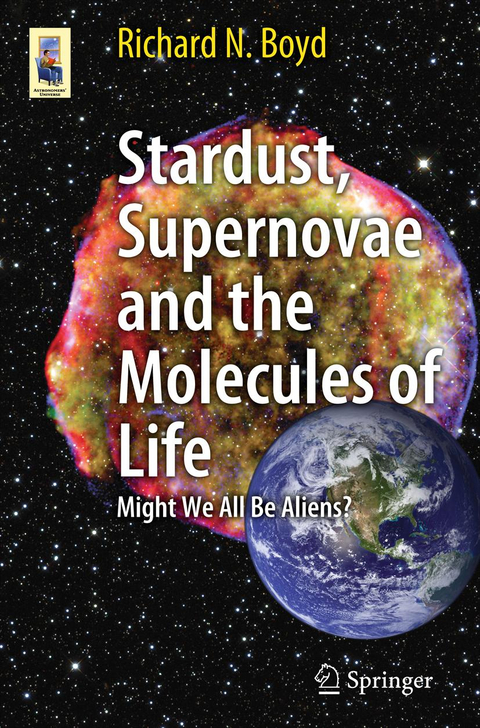Stardust, Supernovae and the Molecules of Life
Springer-Verlag New York Inc.
978-1-4614-1331-8 (ISBN)
Dr. Richard Boyd was the Science Director of the National Ignition Facility, Lawrence Livermore National Lab from 2007-2010 and now serves as a staff physicist at LLNL. He earned his Ph.D. in physics from the University of Minnesota in 1967, and has been a physics professor at the University of Rochester from 1972 to 1978 and a professor of physics and astronomy at Ohio State University from 1984 to 2002. Dr. Boyd also served as a program officer at the National Science Foundation from 2002 to 2006, managing the NSF portfolios in nuclear and particle astrophysics as well as nuclear physics. Following that, he was a visiting professor at the National Astronomical Observatory in Japan. Dr. Boyd has enjoyed a research career that resulted in more than 200 publications, both experimental and theoretical, and one graduate-level textbook on nuclear astrophysics. He was awarded an Outstanding Scholar award from Ohio State University in 1982, and was named a Fellow of the American Physical Society and of the American Association for the Advancement of Science. He was named an honorary Native American of the Santa Clara Pueblo in 1997, and an Eminent Scientist of the Institute for Physical and Chemical Research in Japan in 1998-1999.
Table of Contents.- Preface.- Chapter 1: Introduction.- 1.1: In the Beginning.- 1.2: What is "Life?".- 1.3: The Miller Urey Experiment.- 1.4: General Background and Definitions.- Chapter 2: What is the Origin of the Lightest Elements.- 2.1: The Big Bang.- 2.2: The Supernova Cosmology Project.- 2.3: The Wilkinson Microwave Anisotropy Probe.- 2.4: Olber's Paradox.- 2.5: Big Bang Nucleosynthesis - BBN.- Chapter 3: What is the Origin of the Rest of the Elements?.- 3.1: Introduction to Stellar Nucleosynthesis.- 3.2.1: Hydrogen Burning.- 3.2.2: Helium Burning.- 3.2.3: Subsequent Burning Stages.- 3.3: After Stellar Burning.- 3.3.1: Creating a Core-Collapse Supernova Explosion.- 3.3.2: Synthesizing the Heavy Elements.- 3.3.3: White Dwarfs.- 3.3.4: Type Ia Supernovae.- Chapter 4: Creation of Molecules in the Interstellar Medium.- 4.1: The Electromagnetic Spectrum.- 4.2: Detecting Photons of Different Energies.- 4.3: Secrets from Meteorites.- 4.4: Mining the Comets.- 4.5: The Next Huge Step - Forming Life from the Molecules Delivered to Earth.- Chapter 5: Amino Acids and Chirality.- 5.1: A Primer on Amino Acids.- 5.2: Chirality and Polarization.- 5.3: Relating Optical and Molecular Chirality.- 5.3.1: Chiral Selection.- 5.3.2: A Little Atomic Physics and Some Very Basic Quantum Mechanics.- 5.4: The Other Molecules of Life.- Chapter 6: How Have Scientists Explained the Amino Acid Chirality?.- 6.1: Models that Produce Chirality.- 6.1.1: Chiral Selection via Circularly Polarized Sunlight.- 6.1.2: Chiral Selection via Circularly Polarized Sunlight.- 6.1.3: Chiral Selection via the Weak Interaction.- 6.1.4: Chiral Selection via Chemical Selection in Clay.- 6.2: Amplification via Chemical Catalysis.- 6.3: Laboratory Experiments and Theoretical Developments.- 6.4: Terrestrial Amplification.- 6.5: Concluding Remarks on Amplification.- Chapter 7: What Happens to the Amino Acids When the Supernova Explodes?.- 7.1: The Supernova.- 7.2: The Neutrino Story.- 7.3: Interactionsof Neutrinos with 14N.- 7.4: Relating the 14 N Spin to the Molecular Chirality.- 7.5: The Supernova Progenitor Star.- Chapter 8: Spreading Chirality Throughout the Galaxy and Throughout the Earth.- 8.1: Might Supernovae Process All the Amino Acids in the Galaxy?.- 8.2: Spreading Molecules and Enantiomerism Throughout the Galaxy.- 8.2.1: Cosmic Amplification.- 8.2.2: Cosmic Amplification.- 8.2.2: Galactic Mixing.- 8.2.3: Planetary Amplification.- 8.3: Testing the Models of Amino Acid Chirality.- 8.4: The Impact of Amino Acid Chirality on Questions of the Origin of Life in the Universe.- Chapter 9: What About the Rest of the Universe?.- 9.1: Are We Alone?.- 9.2: Extremophiles on Earth.- 9.3: And From Outer Space?.- Glossary.- Index.
| Reihe/Serie | Astronomers' Universe |
|---|---|
| Zusatzinfo | 26 Illustrations, color; 13 Illustrations, black and white; XI, 215 p. 39 illus., 26 illus. in color. |
| Verlagsort | New York, NY |
| Sprache | englisch |
| Maße | 155 x 235 mm |
| Themenwelt | Sachbuch/Ratgeber ► Natur / Technik ► Weltraum / Astronomie |
| Naturwissenschaften ► Biologie ► Evolution | |
| Naturwissenschaften ► Physik / Astronomie ► Astronomie / Astrophysik | |
| Schlagworte | amino acid chirality • amino acid cosmic processing • amino acid handedness • big bang nucleosynthesis • creation molecules space • life in the universe • Neutrino Physics • origin of life • Springer popular astronomy |
| ISBN-10 | 1-4614-1331-1 / 1461413311 |
| ISBN-13 | 978-1-4614-1331-8 / 9781461413318 |
| Zustand | Neuware |
| Haben Sie eine Frage zum Produkt? |
aus dem Bereich




